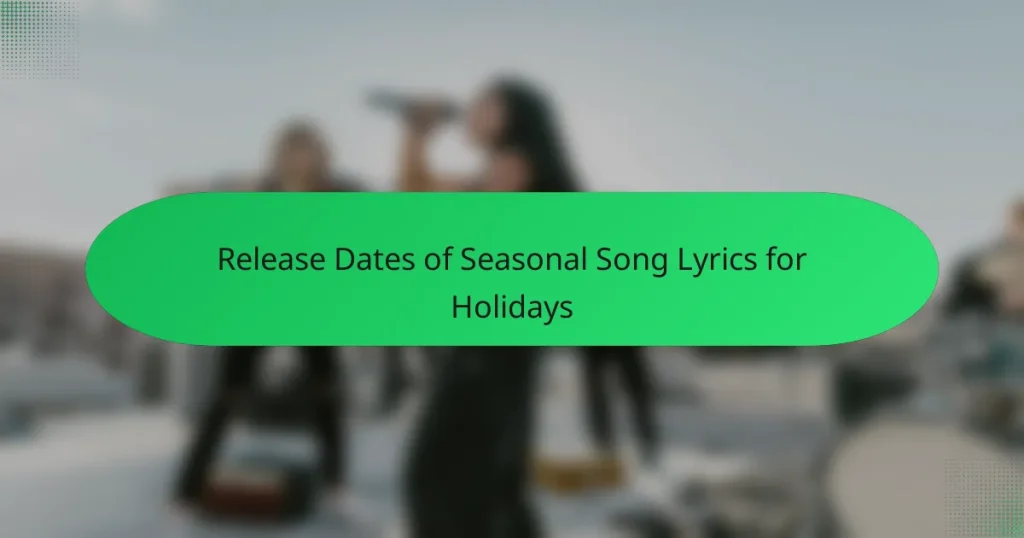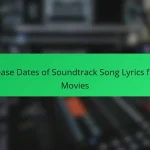The article examines the release dates of seasonal song lyrics associated with various holidays, highlighting how these dates are strategically chosen to enhance listener engagement and align with cultural celebrations. Key factors influencing release timing include seasonal marketing strategies, cultural trends, competition among artists, historical patterns, and data analytics from streaming platforms. Notable examples of holiday songs and their release dates illustrate how established classics and new entries are timed to maximize airplay and sales. The discussion emphasizes the cyclical nature of holiday music and its relevance to consumer behavior during festive seasons.
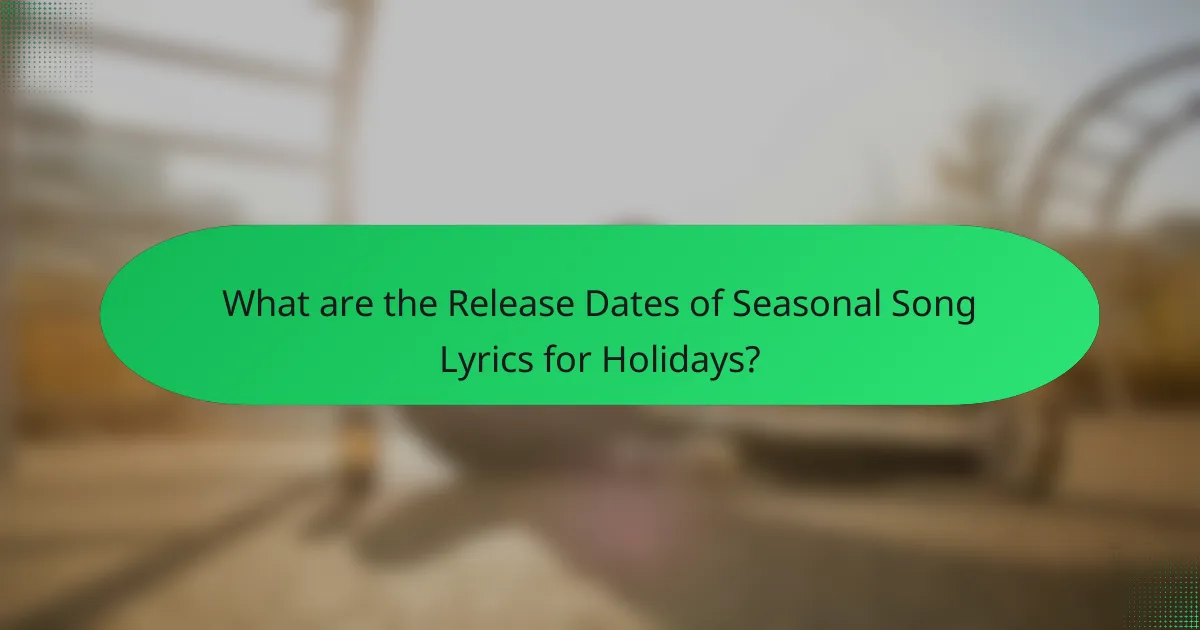
What are the Release Dates of Seasonal Song Lyrics for Holidays?
Release dates for seasonal song lyrics vary by holiday. For Christmas songs, many are released in late October to early November. Thanksgiving songs typically debut in early November. Halloween songs often appear in late September. Valentine’s Day songs are commonly released in January. Easter songs generally come out in March. Each holiday has its peak release period to align with celebrations. This timing helps maximize listener engagement and seasonal relevance.
Why are release dates important for seasonal song lyrics?
Release dates are crucial for seasonal song lyrics because they align with specific holidays or events. Timely releases ensure that songs resonate with the intended audience during peak listening periods. For example, Christmas songs released in November maximize their exposure throughout the holiday season. Additionally, early releases can generate buzz and anticipation among listeners. This strategic timing can influence chart performance and streaming numbers. Historical data shows that songs released close to holidays tend to perform better commercially. Therefore, the timing of release dates significantly impacts the success of seasonal songs.
How do release dates influence holiday song popularity?
Release dates significantly influence holiday song popularity. Timing plays a crucial role in audience engagement. Songs released too early may fade from memory by the holiday season. Conversely, songs released closer to the holiday often capture more attention. For example, songs launched in late November typically align with holiday shopping and festivities. This timing can lead to increased radio play and streaming. According to Nielsen Music, holiday songs see a spike in sales and streams during the final weeks of December. Thus, strategic release dates can maximize a song’s exposure and popularity during the holiday season.
What role do release dates play in music marketing strategies?
Release dates are crucial in music marketing strategies as they influence audience engagement and sales. Timing a release to coincide with holidays can maximize visibility and relevance. For example, songs released during the holiday season often see increased streaming and sales due to heightened consumer interest. Research shows that music released around specific dates can capture seasonal trends, leading to higher chart performance. Additionally, strategic release dates can help artists capitalize on promotional opportunities, such as holiday playlists and events. Thus, selecting the right release date is essential for optimizing marketing efforts and achieving commercial success.
When do popular seasonal songs typically get released?
Popular seasonal songs typically get released several weeks to months before the respective holiday. For example, Christmas songs often debut in late October or early November. This timing allows for radio play and streaming during the holiday season. Halloween songs may be released in September. Valentine’s Day songs are usually launched in January. These release patterns help maximize exposure and sales during peak interest times. Historical trends show that early releases can significantly impact a song’s popularity.
What are the common release periods for Christmas songs?
Christmas songs commonly release between late October and early December. This period aligns with the holiday season’s marketing strategies. Many artists aim to capitalize on the festive spirit. Historically, songs like “Last Christmas” by Wham! were released in the early 1980s in November. Chart performance often peaks in December. Retailers also promote Christmas music during this time. Streaming platforms see increased plays as Christmas approaches. The trend continues annually, with new releases each year around this timeframe.
How do release dates vary for songs related to other holidays?
Release dates for songs related to holidays often align with the specific holiday’s calendar. For instance, Christmas songs typically release in late October or early November. This timing allows for promotion during the holiday shopping season. Similarly, Halloween songs are often released in September. Valentine’s Day songs usually debut in January.
Each holiday has a peak season when listeners are most receptive. For example, summer songs related to Independence Day are often released in late spring. This strategic timing maximizes listener engagement and sales. Seasonal trends in music release dates are well-documented in industry practices.
How can listeners track the release dates of holiday songs?
Listeners can track the release dates of holiday songs through various methods. Music streaming platforms often feature new releases prominently. Services like Spotify and Apple Music have dedicated holiday playlists that update annually. Social media accounts of artists and record labels frequently announce upcoming holiday music. Websites that specialize in music news also provide release calendars. Additionally, music blogs often review and discuss new holiday songs upon their release. Fans can subscribe to newsletters from these sources for timely updates. This approach ensures that listeners stay informed about new holiday music as it becomes available.
What platforms provide information on seasonal song releases?
Music streaming services provide information on seasonal song releases. Platforms like Spotify and Apple Music feature curated playlists for holidays. These playlists often highlight new and popular seasonal songs. Social media platforms like Instagram and Twitter also share updates on song releases. Music blogs and websites, such as Pitchfork and Billboard, publish articles about seasonal music trends. Additionally, music charts and industry reports track seasonal song performance. These sources collectively offer comprehensive insights into seasonal song releases.
How do social media and streaming services impact release date awareness?
Social media and streaming services significantly enhance release date awareness. They provide platforms for artists and brands to announce upcoming releases directly to their audiences. Social media channels like Instagram and Twitter allow for real-time updates and engagement with fans. Streaming services often feature countdowns and notifications for new releases, increasing visibility. Research shows that 79% of consumers are likely to engage with brands on social media when they announce new products. This direct communication fosters anticipation and excitement among fans. Consequently, social media and streaming services play a crucial role in shaping public awareness of release dates.
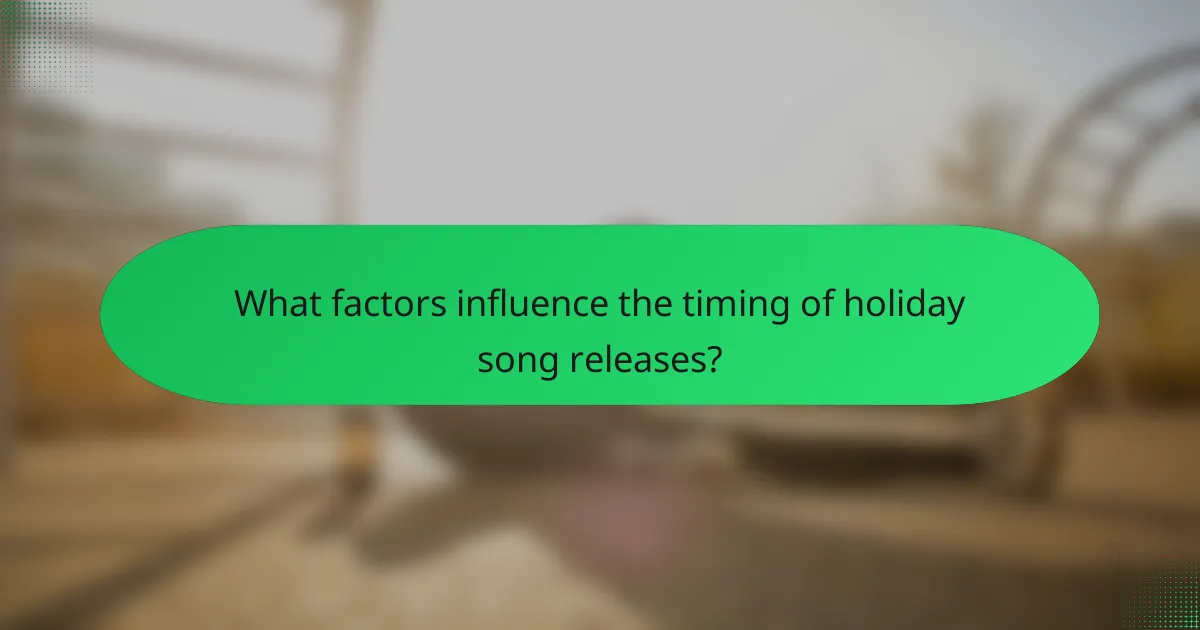
What factors influence the timing of holiday song releases?
The timing of holiday song releases is influenced by several key factors. Seasonal marketing strategies play a significant role. Artists and record labels often aim to capitalize on consumer spending during the holiday season. Release dates are typically scheduled to align with major holidays, such as Christmas and Thanksgiving.
Cultural trends also impact release timing. Songs that resonate with current events or social movements may be released to enhance their relevance. Additionally, competition among artists can dictate release schedules. Many artists choose to release songs early to establish a presence before the peak holiday shopping season.
Historical patterns show that established holiday classics often see re-releases or new versions each year. This creates a cycle where new songs are introduced alongside familiar favorites. Furthermore, streaming platforms influence timing. Data analytics from these platforms can guide artists on optimal release windows based on listener habits.
Overall, strategic marketing, cultural relevance, competition, historical trends, and streaming data collectively influence the timing of holiday song releases.
How do cultural trends affect song release dates?
Cultural trends significantly influence song release dates. Artists often align releases with cultural events or seasonal trends to maximize impact. For instance, holiday-themed songs are typically released in late fall to coincide with festive seasons. Research shows that songs released during relevant cultural moments tend to perform better on charts. A study by Nielsen Music found that holiday music sales peak in November and December. Additionally, cultural movements can inspire timely releases that resonate with current social sentiments. This strategic timing helps artists connect with audiences and enhances the song’s relevance.
What seasonal events drive the release of specific songs?
Seasonal events that drive the release of specific songs include holidays like Christmas, Halloween, and summer. Christmas songs are often released in late October to early November. This timing aligns with the holiday shopping season and festive preparations. Halloween songs typically debut in September, coinciding with Halloween-themed events and parties. Summer anthems are frequently released in late spring, capturing the excitement of summer vacations and outdoor activities. These seasonal releases are strategically timed to maximize audience engagement and sales. For instance, Christmas classics like “All I Want for Christmas Is You” often chart annually due to timely releases.
How do artist schedules impact the timing of releases?
Artist schedules significantly impact the timing of releases. Their availability determines when new music can be recorded and promoted. For instance, artists often have touring commitments that limit their time in the studio. Additionally, the timing of releases is strategically planned around marketing cycles. This includes aligning with holidays or events to maximize audience engagement. Data shows that major releases often occur during peak listening seasons. Thus, artist schedules directly influence both the creation and launch of new music.
What marketing strategies are used around seasonal song releases?
Seasonal song releases utilize various marketing strategies to maximize impact. Artists often leverage social media platforms for promotions. Engaging visuals and countdowns create anticipation among fans. Collaborations with influencers amplify reach and engagement. Targeted advertising campaigns focus on holiday themes to attract listeners. Streaming services often feature seasonal playlists to boost visibility. Email marketing campaigns inform subscribers about new releases. Music videos with festive themes enhance shareability and excitement. These strategies collectively enhance audience engagement and drive sales during peak seasons.
How do promotional campaigns align with song release dates?
Promotional campaigns are strategically timed to coincide with song release dates. This alignment maximizes visibility and engagement for the new music. For instance, artists often launch campaigns weeks in advance of a release. This builds anticipation among fans and the media. Promotions may include social media teasers, music videos, and interviews. These efforts create buzz and drive pre-saves or pre-orders. Successful campaigns often utilize analytics to determine optimal release timing. Historical data shows that songs released during holidays or events achieve higher streaming numbers.
What role does audience engagement play in release timing?
Audience engagement significantly influences release timing. High audience engagement can create anticipation for a release. This anticipation can lead to increased visibility and sales upon launch. For example, artists often release teasers to gauge audience reactions. These reactions help determine the optimal release date. Engaging with the audience through social media can also inform artists about preferred timing. Research indicates that releases aligned with audience interest yield better performance. Therefore, understanding audience engagement is crucial for effective release timing.
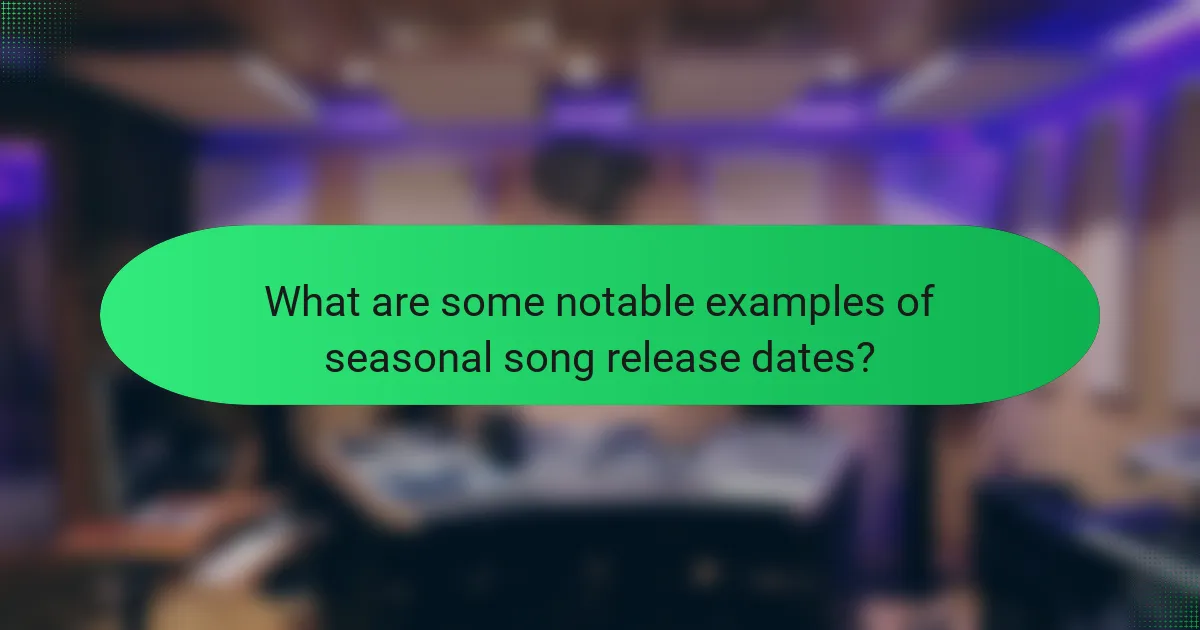
What are some notable examples of seasonal song release dates?
Notable examples of seasonal song release dates include “Last Christmas” by Wham!, released on December 3, 1984. Another example is “Jingle Bell Rock” by Bobby Helms, which was released on November 27, 1957. “Feliz Navidad” by José Feliciano was released on October 28, 1970. Additionally, “All I Want for Christmas Is You” by Mariah Carey debuted on November 1, 1994. These songs are often associated with the holiday season and have become staples during that time. Their release dates are strategically timed to maximize seasonal airplay and sales.
Which holiday songs have had significant release date impacts?
“White Christmas” by Bing Crosby significantly impacted holiday music release dates. Released in 1942, it became an instant classic. The song’s success influenced the timing of holiday music releases thereafter. “Last Christmas” by Wham! also had a notable impact. Released in 1984, it established a new standard for pop holiday songs. These songs shifted the commercial landscape for holiday music. They set benchmarks for other artists in terms of release timing and marketing strategies.
What can be learned from the release strategies of classic holiday hits?
Classic holiday hits often utilize strategic release dates to maximize impact. These songs are typically launched in early November or late October. This timing capitalizes on the holiday season’s buildup. For example, Mariah Carey’s “All I Want for Christmas Is You” was released in 1994 and gained popularity during the holiday season. Releasing songs early allows for radio play and audience familiarity. Additionally, marketing campaigns often align with these releases to boost visibility. Historical data shows that songs released earlier in the season tend to chart higher. This strategy emphasizes the importance of timing in music marketing.
How have recent holiday songs changed the landscape of release dates?
Recent holiday songs have shifted release dates to earlier in the year. Traditionally, holiday music was released in late November or early December. Now, many artists release holiday songs as early as October. This change caters to consumer demand for festive music during the extended holiday season. Streaming platforms also influence this trend by promoting holiday playlists earlier. For example, Spotify and Apple Music feature holiday playlists starting in October. This strategy maximizes listener engagement and revenue opportunities. The trend reflects a broader commercialization of holiday music.
How can fans celebrate and keep track of holiday song releases?
Fans can celebrate and keep track of holiday song releases by following artists on social media. Many artists announce new releases directly to their followers. Fans can also subscribe to music streaming services for notifications. Platforms like Spotify and Apple Music often provide alerts for new holiday music. Additionally, fans can join music forums and communities to share updates. These communities often discuss upcoming releases and favorite songs. Creating playlists of favorite holiday songs can enhance the celebration. Fans can also attend holiday concerts or virtual events to enjoy live performances.
What are the best practices for following new holiday song releases?
To effectively follow new holiday song releases, utilize music streaming platforms and social media. Platforms like Spotify and Apple Music often feature new releases prominently. Following artists on social media ensures you receive real-time updates. Subscribing to music blogs and newsletters provides curated lists of holiday songs. Engaging with online communities can enhance your discovery of new music. Keeping an eye on holiday music charts helps track popular releases. Lastly, setting notifications for specific artists or genres can streamline your listening experience.
How can fans create their own playlists around seasonal song release dates?
Fans can create their own playlists around seasonal song release dates by researching the release dates of songs associated with specific holidays. They can begin by identifying popular seasonal songs and their corresponding release dates. Many music streaming platforms provide information on song release dates. Fans can then curate their playlists by selecting songs that fit the seasonal theme and are released around the same time each year. Utilizing social media and music blogs can also help fans discover new seasonal releases. By organizing their playlists based on these release dates, fans can enjoy a collection of music that enhances the holiday experience.
The main entity of this article is the release dates of seasonal song lyrics for holidays. The article outlines the timing of song releases for various holidays, such as Christmas, Thanksgiving, Halloween, Valentine’s Day, and Easter, emphasizing the importance of aligning these releases with peak audience engagement periods. It discusses how strategic release dates can enhance commercial success, audience anticipation, and streaming performance. Additionally, the article explores the influence of cultural trends, artist schedules, and marketing strategies on the timing of these releases, providing insights on how listeners can stay informed about new seasonal songs.
